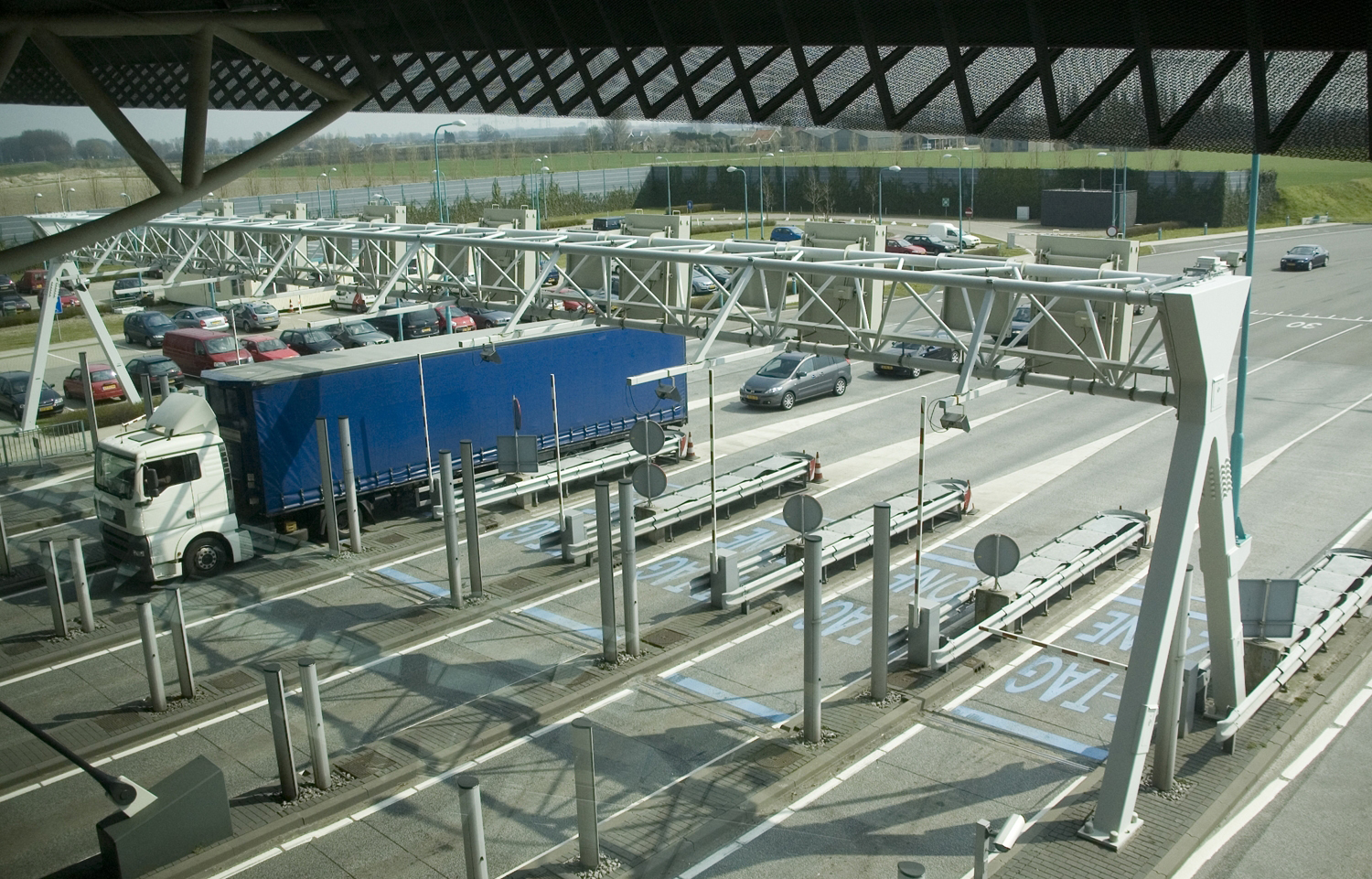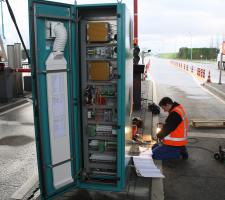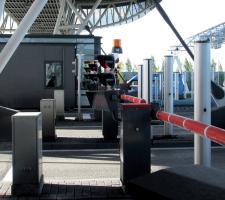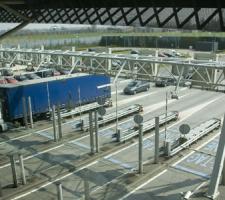
Westerscheldetunnel's toll plaza is 14 lanes wide, seven in each direction
Technolution's Winifred Roggekamp and Dave Marples describe efforts to upgrade the Westerscheldetunnel's tolling system to give free-flow capability.
Until 2003 the Flanders region of Zeeland, in the south-west of the Netherlands, was connected to the mainland only by ferry. The newCollecting the toll
The collection of tolls is an essential part of tunnel operations; the toll charges for the Westerscheldetunnel are intended to recover the costs of tunnel construction over a 30-year timetable. There is a single toll plaza at the north end of the tunnel with seven lanes in each direction and an operations building for support purposes. The tolls can be paid via several mechanisms: cash; electronic payment cards (such as credit or fuel cards); ChipKnip (electronic purse); or tunnel tag (usually shortened to 't-tag'; an infrared Dedicated Short-Range Communications tag with pre-payment model).The use of the t-tag, offering high-speed payment, was already by far the most popular option when work commenced on the new system; some two thirds of tunnel users were electing to use it. The
Structure
The toll plaza is 14 lanes wide (seven in each direction) and the tolling system is distributed between the front office components which deal with the vehicle transaction and lane-specific activities, the front office controller which has oversight over the toll plaza and the state of each of the lanes and the back office system which is responsible for the financial reconciliation process. The front office components are provisioned per lane in each tolling booth, where the front office controller (controller for the plaza manager) and back office system are in the support building at the toll plaza. A further system provides for t-tag reconciliation which is viewed as an external process by the tolling system proper and is modelled as a fully automatic credit card service just liket-tag reconciliation is operated by an organisation known as Movenience B.V., a joint venture of N.V.
Operation
The front office systems implement a largely conventional tolling system but with automatic vehicle type detection and the potential for high-speed operation. In order to determine the toll to be paid vehicles need to be classified according to applicable toll class. Vehicle height is determined by means of light curtains. Length is determined by means of a combination of the light curtains in conjunction with loop detectors in the ground. Sensor sets are placed six metres apart and the combination of outputs from these sets of sensors allows for the detection of cars, cars with trailers or, caravans less than or equal to 2.5m high, trucks less than or equal to 12m long and trucks longer than 12m.The system as developed has proven to be precise enough to even be able to detect the trailer hitch between a car and its associated trailer or caravan and has been demonstrated to have 5cm accuracy at 100km/h. The system also includes treadles as direction sensors that are used to determine if a vehicle is reversing out of a payment lane. This is used to abort a transaction, for example if a driver suddenly discovers that they do not have the means to pay.
Challenges
The primary challenge of the new system was to implement it with no downtime - it was simply not possible to close down the tunnel while the new system was deployed. This has led to a smart migration scheme in which the lane equipment has been refitted according to a carefully predetermined schedule. Meanwhile, close interaction between the old and new back offices has been carefully managed in order to be able to seamlessly process all toll transactions as the systems are switched over.Requirements for the new implementation are centred around improvements in reliability, maintainability and availability with improved flow rates through the plaza. It was essential to retain the sensors that had previously been installed as the cost of installing new ones was prohibitive but the new requirement to be able to support flow speeds of up to 100km/h introduced a whole new set of challenges. A new sensor processing capability was necessary.
The system specification demanded an error rate of 1 in 1,000 vehicle passages. This is no mean feat when tailgating vehicles, vehicles travelling parallel to each other (especially motorcycles) and 'exception' vehicles. These will always be mis-detected no matter how good the quality of the detection algorithm.
The requirement to improve flow through the toll plaza was the primary challenge for the project. This was done by making the charging systems more reliable and user-friendly. In future the system will support the aforementioned 100km/h transit speed, further improving flow rates
Implementation
At each toll booth an I'O controller (PLC-PC) interfaces to the lane-specific sensors and a further industrial fanless PC, running Windows and a .net application, is responsible for the user interface and customer facing functions. These two machines communicate with each other over IP. White and blacklists of credit and charge cards are retained on the lane equipment so that they can perform transactions independent of the back office system. These lists are updated by the back office as required. The lane equipment is also capable of storing transaction records, allowing for autonomous operation when there is no connection possible with the back office.Each tolling booth is connected to the back office via an optical fibre token ring. Fibre token ring is used both to provide galvanic isolation (a few years ago, in the previous system, eight lanes were taken out by a single lightning strike) and to provide a degree of redundancy via the ring structure. Availability is assured by the number of lanes that are provisioned in the system. The back office equipment is based on highly reliable industrial grade equipment with RAID-5 disk arrays further improving system availability.
Each of the lanes' systems deliver vehicle transaction data to the back office system, which is responsible for performing financial reconciliation. Users interact with this system via a web interface or via a call centre operator. If the back office is not available for any reason then each of the front end systems is capable of batching transactions until it comes online again.
The entire system is overseen by a management capability including a Nagios server that monitors the operation of the front and back offices and the network for errant conditions.
Maintenance
Technolution is responsible for the ongoing maintenance of the system. First- and second-line support are provided by onsite staff of the N.V. Westerscheldetunnel and lane equipment can be swapped out quickly and easily for minimal downtime. The entire system is deployed on a private IP subnet and it is possible for Technolution to log in remotely over a virtual private network to be able to perform maintenance operations remotely. These include being able to monitor, or even directly interact with, operator screens. System upgrades can be performed remotely but these are carefully co-ordinated with onsite staff to avoid unexpected consequences.The future
At the time of writing the new Westerscheldetunnel tolling system had just gone live following an extensive trial period. It is expected to deliver significant operational improvements to N.V. Westerscheldetunnel as the operators of the tolling system and further enhancements are planned, such as the high-speed transit already mentioned. In addition, the t-tags of Movenience are now finding wider applicability with the ability to charge for parking now being integrated with the existing functionality.Tolling systems are not common in the Netherlands and the Westerscheldetunnel represents only the second such system anywhere in the country. The enhanced communications that it has brought, coupled with the improved charging systems which are further reducing transit time, are bringing benefits to a community that was previously isolated by difficult road access and poor communications links.














